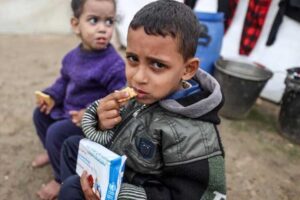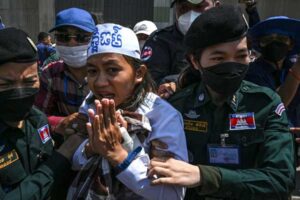
Armed Conflicts, Civil Society, Global Governance, Headlines, Human Rights, Humanitarian Emergencies, IPS UN: Inside the Glasshouse, Middle East & North Africa, TerraViva United Nations

Credit: WFP/Ali Jadallah/2024
– Corinne Fleischer, WFP’s regional director for the Middle East, North Africa and Eastern Europe, describes Gaza as “a terrible situation getting worse.” Over the past two weeks, 21 United Nations World Food Programme (WFP) food distribution points have been closed under evacuation orders.
“UNRWA says that 86% of the Strip is under an evacuation order,” she says on a video call from her office in Cairo. Fleischer visited the enclave in July.“ 2 million people are crammed into 14% of the territory.”
Despite Immense Challenges, WFP Continues to Assist Gazans
With continuous evacuation orders forcing WFP to uproot food distribution sites, precise targeting of the most vulnerable groups becomes challenging. We provide ready-to-eat food, hot meals and nutrition support to breastfeeding women and small children.

Mohammed was severely injured in the conflict but all efforts to evacuate him for medical treatment failed. His family fully depends on food from WFP to survive.
“We support partners in almost 80 kitchens, where they cook meals, pack and distribute them to people in camps,” Fleischer explains. She previously visited Gaza last December. “Then, it was really about how do we bring food in – that’s still very much the case,” she says. “Now, at least we have a dedicated WFP operation on the ground.” Our main accomplishment? “We have helped prevent full-scale famine from happening,” she says.
There are currently nearly 500,000 people at IPC5/Catastrophe, the highest grade of food insecurity on the global standard for measuring food insecurity – down from 1.1 million people earlier this year.
Fleischer is keen to highlight the positive impacts of humanitarian supplies making it through.“Right now, we don’t bring enough food into Gaza,” she says. “We don’t bring in what we plan for the month because we don’t have enough crossing points open. We need all the crossings open and at full capacity.”
“Operations are super complicated,” Fleischer says. “We work in a war zone. Roads are destroyed. We are waiting hours at checkpoints for green lights to move.”
WFP, she stresses, also works to support the wider humanitarian community. “We are leading the Logistics Cluster (the interagency coordination mechanism) and supporting partners to bring in their goods through the Jordan corridor. We are receiving their goods in the north at the Zikim crossing point. We’re helping them in Kerem Shalom. So, of course, we’re helping with fuel supplies too.”
Nowhere Is Safe in Gaza
“Gazans cannot get out, and they’re asking to get out,” Fleischer says. “They’re beyond exhausted. There is no space – one makeshift tent after the other up to the sea. Streets are teeming with people.” Meanwhile, the breakdown of sewage systems, lack of water and waste management means diseases, such as Hepatitis A which is spreading among children, are allowed to fester.
Children eat fortified biscuits from WFP at a makeshift camp in southern Gaza.
“We are lucky that nothing has happened to our amazing staff – more than 200 UNRWA staff have been killed,” she says. “That is not acceptable.” She adds: “We have amazing security officers who advise management on which risks to avoid, so that we can stay and do our work safely and families can access our assistance safely. But the risks are high. Very high. We have bullets close to our convoys. We’re there repairing roads. We’re there moving with our trucks. We’re there reaching people. And it’s very dangerous.”
On the path to recovery, the private sector has a role to play, says Fleischer – take the reopening of shops. “If you think of a lifeline, of hope, or a sense of normalcy, it’s surely when the staple bread is back in the market,” she says of bakeries that have reopened with WFP support. “Bakeries need wheat flour, they need yeast, and diesel too – and that’s where we come in.”
High Prices Keep Basic Foods Out of Reach for Most Gazans
In the south of Gaza, “basic food items are slowly re-emerging in food markets. You can actually find vegetables, fruits in the markets but because prices are high, they remain out of reach for most,” she says “And in any case, people don’t have cash. There are no jobs. Even our own staff tell us, ‘We have a salary, but we can’t access cash’.”
Fleischer is keen for humanitarian efforts to reach a stage where people “stop eating things they have been eating for the past nine months” – to diversify diets heavily dependent on canned food (provided by WFP) and whatever people can get their hands on.
“This level of destruction I’ve never seen.”
Fleischer’s biggest fear for Gaza is “that there is no end to this [war]. That we continue with ever less space for the people who already have nowhere to go back to. Even if they moved back to the north, where could they go?”
“Everything is flattened. There are no homes, it’s all destroyed. We need a long ceasefire that leads to peace so we can operate.”

After the Rafah incursion, many people returned to Khan Younis but there’s no means of living in the area. There are no homes left. Credit: WFP
Fleischer, who has served with WFP in Syria and Sudan’s Darfur Region, adds: “This level of destruction I’ve never seen. Hospitals and clinics are destroyed, food processing plants are destroyed. Everything is destroyed.”
Yet, “There is this never-give-up attitude from the people, from the families we serve,“ she says. “I can’t believe children still run to you and laugh with you. They probably see in us hope that there will be an end to all this – a sign they are not forgotten.”
This story originally appeared on WFP’s Stories on August 8, 2024 and was written by the WFP Editorial Team.
IPS UN Bureau















